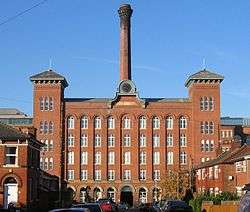Fine Spinners and Doublers
| Industry | Textiles |
|---|---|
| Fate | Acquired |
| Successor | Courtaulds |
| Founded | 1898 |
| Defunct | 1963 |
| Headquarters | Manchester, UK |
Fine Spinners and Doublers was a major cotton spinning business based in Manchester, England. At its peak it was a constituent of the FT 30 index of leading companies on the London Stock Exchange.
History

Fine Spinners and Doublers, formed from a group of spinning companies specialising in fine Sea Island Cottons, was registered on 31 March 1898.[1] The Fine Cotton Spinners and Doublers Association Limited had the objective of promoting the interests of cotton spinners in North West England.[2] It was founded through the efforts of Herbert Dixon and Scott Lings in 1897. Businesses that joined in this enterprise at the time included A&G Murray Ltd, Houldsworths, CE Bennett & Co, James & Wainwright Bellhouse and McConnell & Co; but many more followed in subsequent years.[2][3]
The new association was vast compared with its competitors and its large size enabled it to secure its supplies of cotton from the Sea Island and Egypt.[2] For thirty years it was the world's largest cotton-spinning concern, expanding to operate 60 mills and employ 30,000 operatives.[3]
First World War
In 1915, its vice-president, McConnel was on the RMS Lusitania when she was sunk by enemy action. He survived and wrote an account of the sinking which was published in the Manchester Guardian.[4]
Contraction
In 1938 Lancashire Cotton Corporation replaced Fine Cotton Spinners and Doublers in the FT 30 index as the latter completed a capital reduction and reorganisation programme.[5]
In 1939 the population of Europe was plunged into war. There was a demand for increase supplies of fine cotton to fulfil new usages. These include cotton for electrical insulation in aircraft. Rubberised cotton dinghies including Lindholm apparatus, desalting apparatus and floating rope. 20,000 workers from the Fine Cotton Spinners took part as well as spending any free-time in the Home Guard.
On 16 June 1940 production was stepped up order of Lord Beaverbrook. Sunday working and double shifts were introduced in a plan to quadruple production in order to manufacture defensive Barrage balloons. At peak of production 10 mills were used to output 91,000 kilograms (200,000 lb) of fine super-combed yarn a week; that is 50% of the industry total.[6] Fine super-combed yarn was needed for parachutes and camouflage netting. It was also used for constructing pneumatic heavy lifting gear and inflatable decoy artillery.[7]
In 1946 the name of the business was changed to Fine Spinners' and Doublers' Limited.[2][8] There were 62 firms making up the Association. It owned 107 spinning and doubling mills, a pilot production plant, a weaving mill, a mercerising plant a large research establishment and a 16,000 hectares (39,000 acres) cotton plantation. [9]
During the next five years there was a sustained boom in the textile industry owing to the worldwide shortage of cotton goods. Yarn production increased by 50 percent but output contracted by 28 percent; the Lancashire industry had collapsed.[8]
Closure
Fine Spinners and Doublers was acquired by Courtaulds in 1963.[10]
References
Notes
- ↑ Fine Cotton Spinners and Doublers Association, Graces Guide, retrieved 27 August 2011
- 1 2 3 4 Bellhouse history
- 1 2 Miller & Wild 2007, p. 88
- ↑ McConnel, J.W. (10 May 1915), LANCASHIRE SPINNER'S EXPERIENCE.Under The Sea And Back Again., Manchester Guardian
- ↑ FT 30 History
- ↑ Fine Cotton Spinners and Doublers Association 1947, p. 41.
- ↑ Fine Cotton Spinners and Doublers Association 1947, p. 51-61.
- 1 2 Miller & Wild 2007, p. 91
- ↑ Fine Cotton Spinners and Doublers Association 1947, p. 18.
- ↑ History of Bamford Mill
Bibliography
- Miller, Ian; Wild, Chris (2007), A & G Murray and the Cotton Mills of Ancoats, Lancaster Imprints, ISBN 978-0-904220-46-9
- Fine Cotton Spinners and Doublers Association (1947). Richard Potts and Partners Ltd, ed. Behind the Distaff: An account of the activities of Fine Cotton Spinners and Doublers Association Limited. London, EC4: Fine Cotton Spinners and Doublers Association Limited.
External links
| Bale Breaker | Blowing Room | |||||
| Willowing | ||||||
| Breaker Scutcher | Batting | |||||
| Finishing Scutcher | Lapping | |||||
| Carding | Carding Room | |||||
| Sliver Lap | ||||||
| Combing | ||||||
| Drawing | ||||||
| Slubbing | ||||||
| Intermediate | ||||||
| Roving | Fine Roving | |||||
| Mule Spinning | - | Ring Spinning | Spinning | |||
| Reeling | Doubling | |||||
| Winding | Bundling | Bleaching | ||||
| Weaving shed | Winding | |||||
| Beaming | Cabling | |||||
| Warping | Gassing | |||||
| Sizing/Slashing/Dressing | Spooling | |||||
| Weaving | ||||||
| Cloth | Yarn (Cheese)- - Bundle | Sewing Thread |
